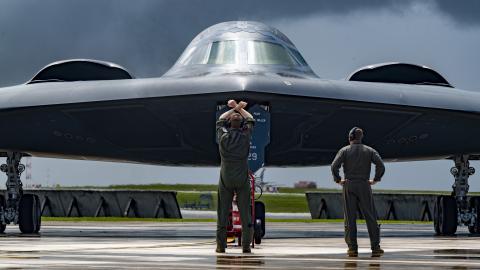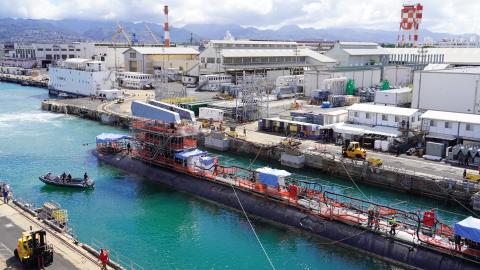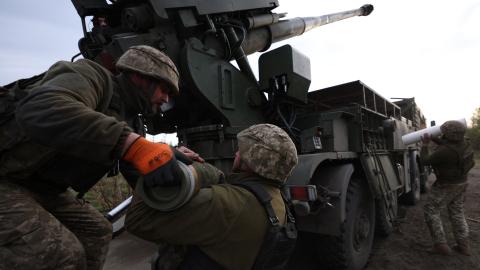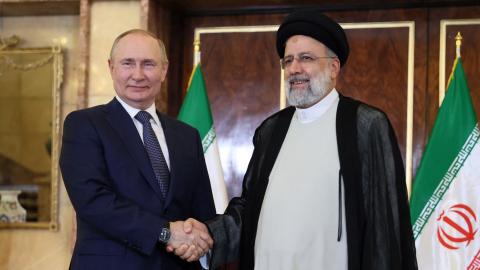Russia’s large-scale invasion of Ukraine in February 2022 has led to a renewed focus on the geopolitical importance of the Black Sea. What the North Atlantic Treaty Organization has overlooked is Russia’s use—often in coordination with Iran—of the Caspian Sea to advance its war aims in Ukraine. The Caspian Sea offers Russia a strategic depth to strike targets far afield in a relatively safe manner, is currently the only way for Russia to reinforce its Black Sea Fleet, and serves as a transport conduit allowing Iran to deliver military assistance to Russia for use against Ukraine.
As Admiral Sir Tony Radakin, the United Kingdom’s chief of the defence staff, recently said, “The flow of Iranian weapons to Russia’s war in Ukraine demonstrates that there is no easy geographical distinction on matters of defense.”1 In the context of regional security, military planners in the United States and NATO should see the most extreme point of the alliance’s Black Sea frontier as the southern shoreline of the Caspian Sea.
A Geopolitical Black Hole
Official documents rarely mention the Caspian Sea. The latest US National Security Strategy, the most recent US Central Asia Strategy, and NATO’s most recent Strategic Concept make no mention of it. The 2022 Posture Statements for US European Command (EUCOM) and US Central Command (CENTCOM)—the two combatant commands covering the region—have a combined word count of more than 16,000 words, and Caspian does not appear once. In US strategic thinking, the Caspian Sea is a geopolitical black hole.
In reality, the Caspian Sea is at the heart of the Eurasian continent and is a crucial geographical and cultural crossroads linking Europe and Asia. For centuries, the region has proven strategically important to many countries for military and economic reasons. Following Russia’s invasion of Ukraine in February 2022, the Caspian Sea region caught the attention of Western policymakers, but they narrowly focused on energy and transport. Seeking quick and dependable alternatives to Russian energy, the European Union scrambled to the region to secure new energy deals. Last year, for example, the EU signed a deal with Azerbaijan to double the amount of gas it transports from the Caspian Sea through the Southern Gas Corridor by 2027.2
Projection of Russian Power
However, in the broader discussion about the Caspian Sea, NATO has given little attention to security. For Moscow, the Caspian Sea plays a key role in the projection of Russian power in a way Western capitals fail to understand. This role has direct implications for NATO’s Black Sea security for three reasons.
1. Transport via the Volga-Don Canal
One of the two canals connecting the Caspian Sea to the outside world is the Volga-Don Canal, which links it to the Black Sea via the Sea of Azov. This canal is 63 miles long and, as the name suggests, connects the Don and Volga Rivers. Its primary purpose is commercial transport.
However, during the spring and summer months, when the canal is not frozen, Russia uses it to move warships and military supplies between the Caspian Sea and the Black Sea. Ships from Russia’s Caspian Flotilla have played a direct role in supporting Russia’s invasion of Ukraine since 2022.
With Turkey’s closure of the Turkish Straits entering the Black Sea, Russia’s Caspian Flotilla serves as the only means of reinforcing the Black Sea Fleet. Realizing how important the canal is, Moscow recently announced a $1 billion investment to modernize the waterway. Not only will this make the canal more dependable to move military supplies and equipment between the Caspian and Black Seas, but it will also increase trade opportunities with Iran.
2. Missile Launches
Russian warships operating from the Caspian Sea have launched cruise missiles against Ukraine. In the past, Russian cruise missiles from the Caspian also hit targets in Syria. The use of the Caspian for seaborne cruise missile launches gives Russia a strategic depth and a degree of protection not found in more contested areas, like the eastern Mediterranean or the Black Sea.
Using Caspian-based naval assets to strike targets in Ukraine and Syria helps Moscow with both military objectives and Caspian geopolitics. These missile strikes send a strong signal to other Caspian countries that Russia is the dominant military power in the region.
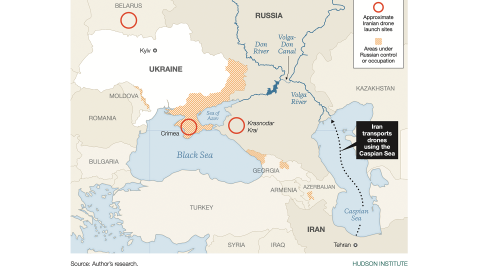
3. Russia-Iran Cooperation
Iran and Russia share many goals in the Caspian region. Russia-Iran cooperation in the Caspian threatens the broader region, including NATO and its partners. Iran has delivered drones that Russia has used against Ukraine either via the Caspian and Volga-Don Canal to occupied Crimea or via an air corridor over the sea. The Russian and Iranian navies also conduct joint military exercises in the Caspian. Experts have long suspected that Iran has transported oil to Russia using the Caspian as a way to skirt economic sanctions.
Goals in the Region
After years of neglecting the region, the US has few options to advance its national interest in the Caspian. This was not always the case.
More than two decades ago, in the aftermath of the September 11 attacks, the US took this region seriously as it was an important gateway to Afghanistan. Senior US officials made regular visits to the region, mentioned it in combatant command posture statements,3 and factored it into strategic thinking. The US started the Caspian Guard Initiative (CGI) in 2003. At the time, the CGI was described as “an initiative which established an integrated airspace, maritime and border control regime for the nations of Azerbaijan and Kazakhstan.”4 During this time, the US Coast Guard gave three cutters to Azerbaijan. In a twist of geopolitical irony, these ships traveled from the US to Azerbaijan via the Black Sea, Sea of Azov, and Volga-Don Canal to the Caspian Sea. This is unimaginable today.
Regarding the maritime situation in the Caspian, the main US strategic goal should be to help regional partners maintain a balance among the five Caspian powers so that one country (Iran or Russia) does not have overwhelming maritime power in the region. It is unrealistic to believe that a single Caspian state will ever match the firepower of Russia. This should not be the goal. Instead, US policymakers should strive to help friendly countries in the region mitigate, balance, and deter any possible Russian or Iranian malign activity. Ultimately, this approach will bring stability to the region in line with US interests. With a sizable portion of Russia’s Caspian Flotilla devoted to operations in the Black Sea and Sea of Azov, this goal has never been more achievable.
On a tactical level, the main US goal in the Caspian region should be to help friendly countries secure their maritime borders, protect vital energy infrastructure, stop the flow of terrorists, prevent terror attacks, ensure the free flow of commerce, and prevent the transfer of illegal weapons and drugs.
The Way Ahead
The ability to move warships from the Caspian Sea to the Black Sea (and vice versa) allows Russia to project power in an important area of the world while giving Russian policymakers flexibility and options during times of conflict in the broader region. The Caspian Sea is a strategic, if often overlooked, region for the transatlantic community. Russia sees the Caspian and Black Seas as one geopolitical space—and so should US and NATO military planners and policymakers.
Though the US is limited in what it can achieve in the Caspian region for the time being, this is no excuse to ignore it. There is a huge policy space between doing nothing at all and having the American ensign plow the Caspian’s waters. To achieve its geopolitical goals in the region, the US should take the following measures.
1. Increase US diplomatic presence in the region.
The last US secretary of state to visit Azerbaijan was Hillary Clinton in 2012. The last US defense secretary to visit there was Robert Gates in 2010. High-level diplomatic presence on the eastern shore of the Caspian is hardly better. Secretary Antony Blinken recently visited Kazakhstan in March 2023, but this was three years after Mike Pompeo’s visit in early 2020. John Kerry was the most recent secretary of state to visit Turkmenistan in 2015. The most recent visit to Kazakhstan and Turkmenistan by a US defense secretary were made by Donald Rumsfeld in 2004 and 2002, respectively. Meanwhile, senior Russian, Chinese, and Iranian officials routinely visit Baku, Astana, and Ashgabat. Once the US starts to engage more with the region to build trust and relationships, there will be more opportunities to work with friendly Caspian countries.
2. Get creative with US maritime engagement.
Since the US Navy will never have a presence on the Caspian, the US should provide training opportunities, officer exchanges, and equipment modernization wherever possible. One of the biggest maritime capability gaps in the Caspian is maritime domain awareness, so the US should focus on its support in this area by providing coastal radar stations, radar for ships, and communication equipment to help improve command and control.
3. Remember the US Coast Guard.
The types of security challenges that US partners face in the Caspian Sea are issues often handled by the US Coast Guard. NATO should not ignore this important asset when developing a strategy for US engagement in the Caspian region. The US Coast Guard has a lot to offer regional countries in terms of training, and it has experience operating around the world to advance US interests. Due to the complex geopolitical situation that some Caspian countries face with Russia, Iran, and China, cooperation with the US Coast Guard, instead of the US Navy, might sometimes be politically easier.
4. Help regional countries improve security and defense capabilities.
In the Caspian region, sovereignty equals security. This means respecting other countries’ sovereignty and being able to defend one’s own sovereignty. The US should work bilaterally and, when appropriate, through NATO to improve the security and military capabilities of partners in the region. In particular, the US should work with Turkey to improve the security and military capabilities of partners in the region. In some countries, such as Turkmenistan, the US should seek to deepen defense and security ties, but not in an overt or public way.
5. Assist regional countries to apply Ukraine’s lessons in the Black Sea to the Caspian.
The combat-tested maritime defense capabilities that Ukraine rapidly developed offer an opportunity to improve the security of the Caspian Sea. Ukraine’s domestically produced anti-ship cruise missile Neptune—combined with disruptive weapons systems that it has creatively used and adapted, like the Bayraktar TB2 drones, Harpoon anti-ship missiles, and Naval Strike Missiles—has proven effective at coastal defense. NATO could apply lessons Ukraine has learned to a new generation of coastal defense and a new concept of operations (CONOPS)—centered on robotic warfare capabilities, information superiority, and an anti-ship missile advantage—which could be relevant in places like the Caspian Sea.
6. Provide military and security assistance to deserving regional partners.
The US government should base its decision to provide military assistance to another country on American security interests and not on lobbying by pressure groups. Section 907 of the Freedom Support Act is an unfair impediment to action in the interest of US security.



